
The Sierra de la Laguna is a mountain range at the southern end of the Baja California peninsula in Mexico, and is the southernmost range of the Peninsular Ranges System.

Primula clevelandii, with the common name of Padre's shooting star, is a species of primrose.
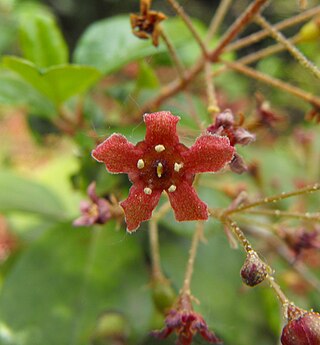
Ribes viburnifolium, is an uncommon North American species in the gooseberry family. It is known by the common names Catalina currant, Santa Catalina Island currant, island gooseberry and evergreen currant.
The monotypic genus Yabea contains the single species Yabea microcarpa, which is known by the common names California hedge parsley and false carrot. It is similar in appearance to other species of wild carrot and relatives. It is native to western North America, including the western United States, British Columbia and Baja California. It grows in many types of habitat.

Ornithostaphylos is a monotypic plant genus which contains the single species Ornithostaphylos oppositifolia, commonly known as the Baja California birdbush or Baja California manzanita. A large, evergreen shrub in the heather family, this species is near-endemic to northwestern Baja California, with a small population just north of the border in San Ysidro, California. It produces a much-branched inflorescence of white, urn-shaped flowers, and has leathery leaves that appear opposite or in whorls. These characteristics separate it from its close relatives in the region, which include manzanitas (Arctostaphylos), summer holly (Comarostaphylis) and mission manzanita (Xylococcus).
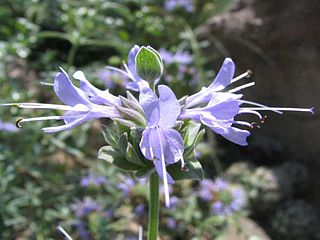
Salvia clevelandii, the fragrant sage, blue sage, Jim sage and Cleveland sage, is a perennial plant that is native to Southern California and northern Baja California, growing below 900 m (3,000 ft) elevation in California coastal sage and chaparral habitat. The plant was named in 1874 by Asa Gray, honoring plant collector Daniel Cleveland.

Heuchera brevistaminea is a rare species of flowering plant in the saxifrage family known by the common name Laguna Mountains alumroot. It is endemic to the Laguna Mountains of San Diego County, California. It grows in rock crevices and steep cliffsides in chaparral and yellow pine forest habitats. This is a rhizomatous perennial herb producing an inflorescence up to 25 centimeters tall. The flowers are bright pink or magenta.

Plantago erecta is a flowering plant in the plantain family, commonly known as the California plantain, foothill plantain, dot-seed plantain, English plantain, and dwarf plantain. Plantago erecta is a small, unassuming annual herb with needle-like leaves and translucent flowers clustered on a stalk. It grows in sandy, clay, or serpentine soils, on grassy slopes and flats or open woodland, found in Baja California, California and Oregon. Plantago erecta is a host species for the Edith's checkerspot butterfly.
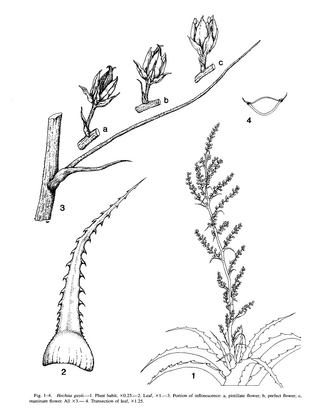
Hechtia gayorum is a species of plant in the genus Hechtia and is the only monoecious species within the genus. It is known commonly as the Gay hechtia. This species is endemic to a small region west of San José del Cabo in Baja California Sur, Mexico.
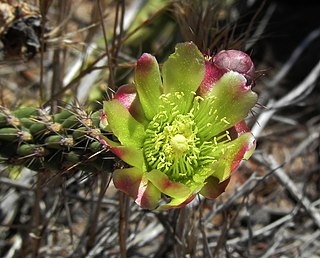
Cylindropuntia californica is a species of cholla cactus known by the common name snake cholla. It is primarily found in Baja California, Mexico and the southernmost part of California in the United States. It is characterized by a short, decumbent habit, yellow-green flowers, elongated stems, and short spines. It is mostly found in coastal sage scrub and coastal chaparral habitats, but two varieties in Baja California can be found in foothills and deserts. In California, variety californica is regarded as a rare and threatened plant, with a California Native Plant Society listing of 1B.1, in part due to its limited number of occurrences and threats from development. It formerly was considered to have a larger range due to the inclusion of Cylindropuntia bernardina within it as the variety parkeri.

Salvia subincisa, the sawtooth sage or sharptooth sage, is a small erect Salvia species that is native to New Mexico, Arizona, and Texas in the United States, and the Baja California peninsula, Chihuahua, and Sonora in Mexico. It is typically found growing in sandy areas near roadsides or other arid parts of the American southwest. It is very often associated with Pueblo ruins in New Mexico, along with Cleome serrulata and Lithospermum caroliniense.

Ferocactus fordii is a species of succulent plant in the family Cactaceae, commonly known as Ford's barrel cactus, endemic to the Baja California Peninsula of Mexico. It is spherical, growing to 50 cm (20 in) in diameter, with whitish-grey radial spines and solitary flowers of a deep rose pink, 4 cm (2 in) in diameter.
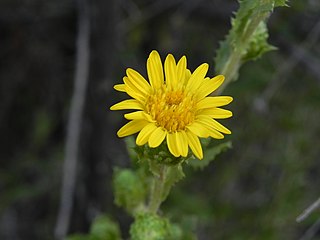
Hazardia berberidis is a species of flowering plant in the family Asteraceae commonly known as the barberry-leaf goldenbush. A woody shrub, it is characterized by sawtooth leaves and yellow ray flowers that bloom from March to August. It is endemic to the coastal sage scrub and coastal succulent scrub habitats of Baja California, Mexico, but with populations of uncertain origin in San Diego County, California.

Ethel Bailey Higgins was an American botanist and the curator of botany at the San Diego Natural History Museum from 1943 to 1957; she continued to serve as associate curator from 1957 to 1963. Higgins authored Our Native Cacti (1931), and other popular works on plants of the southwestern United States and northern Mexico.

Ferocactus chrysacanthus, commonly known as the Cedros barrel cactus, is an endangered species of cactus endemic to the islands of Cedros and West San Benito off the Pacific coast of Baja California, Mexico. It is a solitary-stemmed barrel cactus with a globose to short cylindrical shape, and grows to 1 m (3.3 ft) tall. The yellow to orange flowers bloom from June to July, and mature into yellow fruits. Sometimes recognized is the subspecies grandiflorus, which has orange to red flowers up to 6 cm (2.4 in) long and is native to the Vizcaíno Peninsula of Baja California Sur.
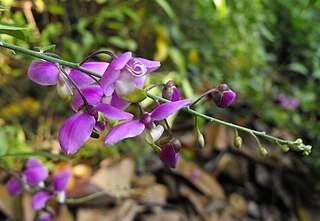
Asemeia apopetala is a species of flowering plant in the milkwort family commonly known as Brandegee milkwort or rama mora. It is a shrub or a small tree characterized by showy pink to magenta flowers that bloom from September to November or any time of year with ample rainfall. It was first described in 1889 and is endemic to Baja California Sur, Mexico. It is the type for the subgenus Apopetala of Asemeia.

Gambelia is a genus of flowering plants in the Antirrhineae tribe of the plantain family commonly known as bush snapdragons. This genus is native to northwestern Mexico, particularly the Baja California Peninsula, but species are also found on the coast of Sonora, Guadalupe Island, and the Channel Islands of California. The genus is named in honor of William Gambel (1823–1849), an American naturalist, ornithologist, and botanist.

Fraxinus parryi, known by common names chaparral ash, crucecilla, and fresnillo, is a species of ash native to southwestern North America, growing as a shrub or a small tree.

Jacquemontia abutiloides is a species of vining plant in the bindweed family (Convolvulaceae) commonly known as the felt-leaf clustervine or felt-leaf morning-glory. A perennial characterized by wooly leaves and blue to whitish flowers, this species grows as a woody plant to shrub with vining upper stems. Flowering is from September to June. It is near-endemic to the Baja California peninsula, Mexico, concentrated mostly around the central peninsula south of the Vizcaino Desert, and found on some of the coastal islands.
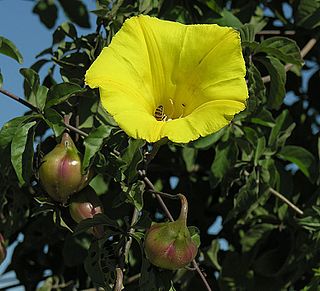
Distimake aureus is a species of vining plant in the bindweed family (Convolvulaceae) commonly known as the yellow morning-glory, yellow woodrose or yuca vine. A woody vine, this species is characterized by its large trumpet-shaped yellow flowers that bloom year-round, though most often after rain. Each of the showy flowers are only open for a single day. It is endemic to Baja California Sur, Mexico, where it can be found twining and climbing over trees, shrubs, and rocks.


















